Conservatoire à rayonnement régional de Poitiers
Conservatoire à rayonnement régional de PoitiersDance schools in FranceEducation in Nouvelle-AquitaineMusic schools in France
The Conservatoire à rayonnement régional de Poitiers is a school of higher education for music, drama, and dance located in Poitiers, France. The institution is a charter school of France's Ministry of Culture and is operated by the Direction régionale des affaires culturelles. The conservatory awards degrees in music performance, music education, choreographic studies, and theater.
Excerpt from the Wikipedia article Conservatoire à rayonnement régional de Poitiers (License: CC BY-SA 3.0, Authors).Conservatoire à rayonnement régional de Poitiers
Rue Saint-Germain, Poitiers
Geographical coordinates (GPS) Address Phone number Nearby Places Show on map
Geographical coordinates (GPS)
| Latitude | Longitude |
|---|---|
| N 46.5864 ° | E 0.3432 ° |
Address
Conservatoire à Rayonnement Régional de Grand Poitiers (Conservatoire National de Région)
Rue Saint-Germain
86000 Poitiers
Nouvelle-Aquitaine, France
Open on Google Maps







